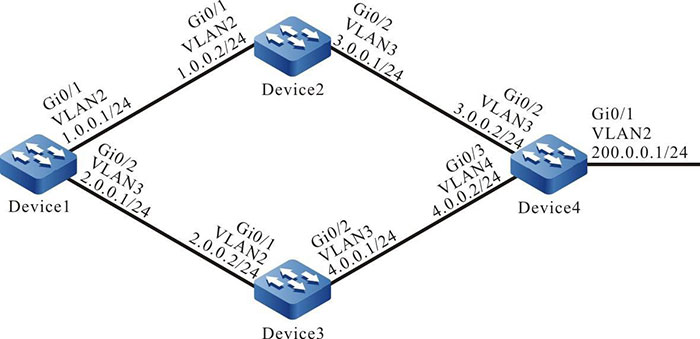Network Requirements
- RIPv2 runs between Device1, Device2, Device3, and Device4.
- Device1 learns route 200.0.0.0/24 from both Device2 and Device3.
- On Device1, set the route metric offset in the receive direction so that Device1 selects the route advertised by Device2 with priority.
Network Topology

Figure 5-3 Networking for configuring the RIP Metric Offset
Configuration Steps
Step 1: Create VLANs, and add ports to the required VLANs. (Omitted)
Step 2: Configure IP addresses for the ports. (Omitted)
Step 3: Configure RIP.
#Configure Device1.
|
Device1#configure terminal
Device1(config)#router rip
Device1(config-rip)#version 2
Device1(config-rip)#network 1.0.0.0
Device1(config-rip)#network 2.0.0.0
Device1(config-rip)#exit
|
#Configure Device2.
|
Device2#configure terminal
Device2(config)#router rip
Device2(config-rip)#version 2
Device2(config-rip)#network 1.0.0.0
Device2(config-rip)#network 3.0.0.0
Device2(config-rip)#exit
|
#Configure Device3.
|
Device3#configure terminal
Device3(config)#router rip
Device3(config-rip)#version 2
Device3(config-rip)#network 2.0.0.0
Device3(config-rip)#network 4.0.0.0
Device3(config-rip)#exit
|
#Configure Device4.
|
Device4#configure terminal
Device4(config)#router rip
Device4(config-rip)#version 2
Device4(config-rip)#network 3.0.0.0
Device4(config-rip)#network 4.0.0.0
Device4(config-rip)#network 200.0.0.0
Device4(config-rip)#exit
|
#Query the routing table of Device1.
Device1#show ip route
Codes: C - Connected, L - Local, S - static, R - RIP, B - BGP, i-ISIS
U - Per-user Static route
O - OSPF, OE-OSPF External, M - Management, E - IRMP, EX - IRMP external
C 1.0.0.0/24 is directly connected, 00:23:06, vlan2
C 2.0.0.0/24 is directly connected, 00:22:56, vlan3
R 3.0.0.0/24 [120/1] via 1.0.0.2, 00:13:26, vlan2
R 4.0.0.0/24 [120/1] via 2.0.0.2, 00:11:04, vlan3
C 127.0.0.0/8 is directly connected, 76:51:00, lo0
R 200.0.0.0/24 [120/2] via 1.0.0.2, 00:08:31, vlan2
[120/2] via 2.0.0.2, 00:08:31, vlan3
According to the routing table of Device1, two routes to 200.0.0.0/24 are available.
Step 4: Configure the ACL.
#Configure Device1.
|
Device1(config)#ip access-list standard 1
Device1(config-std-nacl)#permit 200.0.0.0 0.0.0.255
Device1(config-std-nacl)#commit
Device1(config-std-nacl)#exit
|
Step 5: Configure a metric offset.
#On Device1, configure the metric offset list and increase the metric of the route that has been learnt from interface VLAN3 and matches AL to 3.
|
Device1(config)#router rip
Device1(config-rip)#offset-list 1 in 3 vlan3
Device1(config-rip)#exit
|
Step 6: Check the result.
#Query the routing table of Device1.
Device1#show ip route
Codes: C - Connected, L - Local, S - static, R - RIP, B - BGP, i-ISIS
U - Per-user Static route
O - OSPF, OE-OSPF External, M - Management, E - IRMP, EX - IRMP external
C 1.0.0.0/24 is directly connected, 00:33:59, vlan2
C 2.0.0.0/24 is directly connected, 00:33:50, vlan3
R 3.0.0.0/24 [120/1] via 1.0.0.2, 00:24:20, vlan2
R 4.0.0.0/24 [120/1] via 2.0.0.2, 00:21:57, vlan3
C 127.0.0.0/8 is directly connected, 77:01:54, lo0
R 200.0.0.0/24 [120/2] via 1.0.0.2, 00:19:25, vlan2
According to the routing table of Device1, the next-hop output interface of route 200.0.0.0/24 is only VLAN2, indicating that Device1 has selected the route advertised by Device2 with priority.

-
The route metric offset list can be applied to all interfaces or a specified interface, and it can be used in both the receive and advertisement directions.
 Switch
Switch Wifi - Access Point
Wifi - Access Point Firewall
Firewall Router
Router Module Quang
Module Quang![Module Quang Cisco]() Module Quang Cisco
Module Quang Cisco![Module quang HPE]() Module quang HPE
Module quang HPE![Module quang Maipu]() Module quang Maipu
Module quang Maipu![Module quang Brocade]() Module quang Brocade
Module quang Brocade![Module quang Fortinet]() Module quang Fortinet
Module quang Fortinet![Module quang Aruba]() Module quang Aruba
Module quang Aruba![Module quang OEM]() Module quang OEM
Module quang OEM![Module quang Juniper]() Module quang Juniper
Module quang Juniper![Module quang Dell]() Module quang Dell
Module quang Dell![Module quang Palo Alto]() Module quang Palo Alto
Module quang Palo Alto![Module quang Huawei]() Module quang Huawei
Module quang Huawei![Module quang Arista]() Module quang Arista
Module quang Arista![Module quang F5]() Module quang F5
Module quang F5![Module quang H3C]() Module quang H3C
Module quang H3C![Module Quang Allied Telesis]() Module Quang Allied Telesis
Module Quang Allied Telesis![Module quang SonicWall]() Module quang SonicWall
Module quang SonicWall![Module quang Mikrotik]() Module quang Mikrotik
Module quang Mikrotik![Module quang Handar]() Module quang Handar
Module quang Handar Máy chủ (Server)
Máy chủ (Server) Thiết bị lưu trữ (SAN, NAS)
Thiết bị lưu trữ (SAN, NAS) Load Balancing
Load Balancing Video Conferencing
Video Conferencing Phụ kiện máy chủ
Phụ kiện máy chủ Thiết Bị IoT
Thiết Bị IoT Phụ Kiện Mạng
Phụ Kiện Mạng




.png)
























